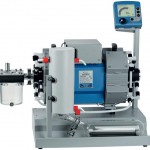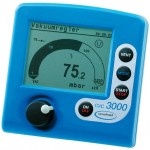Chemical diaphragm vacuum pumps represent an ideal solution for process applications in research and technology centres or large-scale laboratories. They feature very good resistance to chemicals, high performance levels and low operating costs. Systems with a variable rotation speed can be readily integrated in a process control system, e. g. using a PC or PLC.
Dr. Jürgen Dirscherl
There are two main trends in the operation of process vacuum systems: the volumes processed are getting smaller, at least in the pre-stages of real large-scale production. This means the system size is also shrinking so that more compact systems are needed. Process control is becoming more and more intelligent. This is equally true of vacuum control, of course. It is important in this connection to understand that the chemical diaphragm vacuum pumps widely used in laboratories are also playing an increasingly dominant role in the world of larger-scale processes and systems.
Convincing advantages
Chemical diaphragm pumps are meanwhile available with pumping speeds up to about 10 m³/h and 1 mbar ultimate vacuum. Even though this is still at the lower end of the useful range for many processes, the advantages of these systems compared to conventional process vacuum generators such as water ring pumps, or to large oil-free pumps like screw or claw types, are altogether convincing:
- No contaminated wastewater (in contrast to water ring pumps)
- Lower purchase price
- Lower operating costs (energy, water)
- Lower maintenance expenditure
- Chemical-resistant system because the interior surfaces are made entirely of fluoroplastic materials
- Simple solvent recovery by means of exhaust vapour condensation
- High-precision vacuum control, excellent energy efficiency and even lower maintenance expenditure are achievable with variable-speed systems
Chemical diaphragm pumps are thus right at the focus of the trend towards more efficient and more intelligent systems. In order to supply products that go along with this trend, Vacuubrand has supplemented its family of large-scale chemical diaphragm pumps with variable-speed versions using the CVC 3000 vacuum controller, and in doing so raised the performance capacity of these Vario pumps even further. The interiors of the large-scale chemical dia-phragm pumps are made entirely of fluoroplastics or elastomers such as FFKM. The suction chamber is hermetically sealed from the drive chamber by means of a PTFE sandwich-design diaphragm. In addition to the variable-speed versions, which can be fully integrated in a process control system, these pumps are also available with conventional fixed-speed drives. One example is the MV 10C unit. The pumping unit version PC 8 is fitted with an emission condenser for solvent recovery.
Interfaces to the process
The variable-speed Vario pumps feature process-specific control by the CVC 3000. This continuous vacuum control principle makes for precise regulation and allows fully automatic boiling point pressure determination and tracking. The continuous regulation feature increases evaporation efficiency and the process runs faster. The variable – and thus demand based – pump motor speed reduces noise and vibration to a minimum and increases the useful lifetime of the diaphragms and valves, so that many years of uninterrupted operation are possible. The high-res graphic display of the CVC 3000 vacuum controller provides users with all the information they need for their current application in a clear and easy-to-understand form. During the process, the actual vacuum level is displayed as a digital and analogue value with a resolution of 0.1 mbar. Important status information and the vacuum setting are also displayed. Alternatively, a graphic image of the pres-sure-time curve can be selected.
The CVC 3000 features an integrated vacuum sensor made of aluminium oxide ceramic. This pressure sensor provides high measurement accuracy, regardless of the gas type used, as well as a high level of thermal stability. All of the materials in contact with media are chemically resistant. The pres-sure sensor unit includes an integrated aeration valve with an inert gas connection in case aeration with a gas other than air is required. The controller controls suction line valves, cooling water valves, external aeration valves and Vario pumps, and it can also read out external sensors. Communication with these components is realised using the digital Vacuu·Bus. This system has several advantages such as flexibility and self-configuring functionality, which underlie its ease of installation and operator-friendly design. The CVC 3000 can of course also be controlled from a PC or PLC via an RS 232 C interface. The interface is bidirectional and supports the entire range of functions. This facilitates complete integration in an existing process control system, including online monitoring of the process vacuum levels. Recording the speed values even permits automatic maintenance monitoring in an external control unit.
The controller features all of the functions required for process control, from vacuum regulation based on a set vacuum level to “pump-down” with an adjustable suction capacity (1 to 100 %) or fully automatic evaporation with automated boiling point determination and tracking. The last process, which is automatically logged, can be archived permanently in a program memory and subsequently edited or exported. The vacuum controller has ten programs for this purpose that can be called up, edited and individually stored. Up to ten time/vacuum level pairs can be saved in each program, and all of the required control functions such as aeration, etc. can be activated. These functions are typically used in the field of pharmaceutical production, which requires precisely reproducible processes, or general process engineering – for example for degassing a solvent mixture at reduced pressure before the actual evaporation step, which may be fully automated, is carried out.
The combination of a CVC 3000 vacuum controller with a chemical diaphragm pump with a variable-speed drive results in a complete, high-performance system. The figure shows the example of a PC 3012 Vario chemistry pumping unit with a CVC 3000 vacuum controller, an eight-cylinder chemical diaphragm pump, an emission condenser for solvent recovery and an inlet side separator. A typical application of this pumping unit would be at a small-scale production centre or large-scale laboratory. The solvent volumes processed at such locations are easily managed with a system like this. The wide choice of chemical diaphragm pump combinations available for process engineering with suitable accessories and drive variants means the optimal pump can be found for every application. In case of a potential explosion hazard, chemical diaphragm pumps with Atex approval for use up to Zone 1 are also available for applications in hazardous areas or for pumping off inflammatory mixtures. In addition to smaller versions, Vacuubrand offers the powerful MV 10C EX with a pumping speed of 10 m³/h and an ultimate vacuum of 2 mbar.
cpp 430
Vakuumcontroller CVC 3000
Service-Seminare Vacuubrand
Share:








